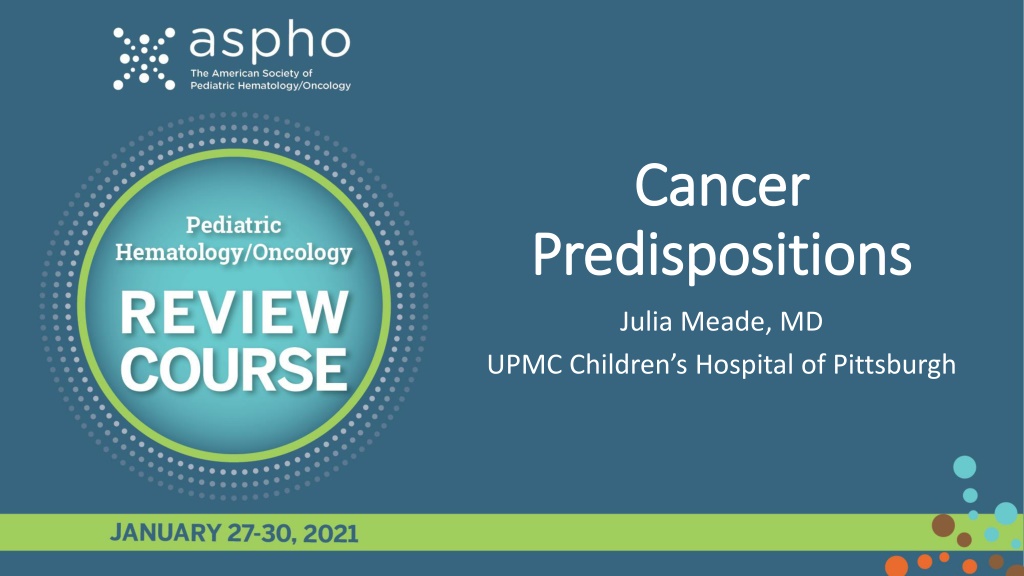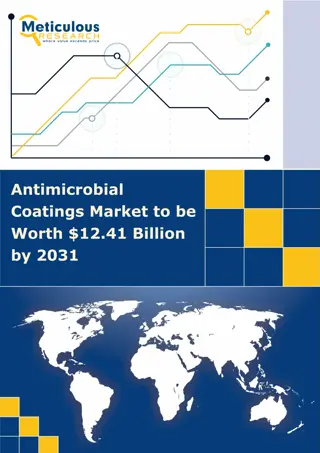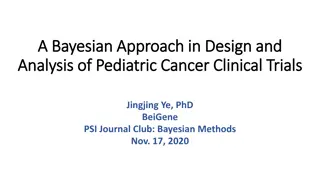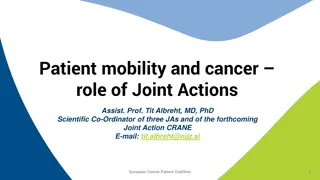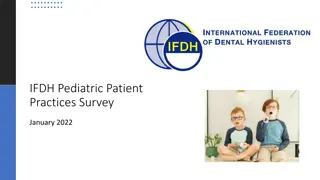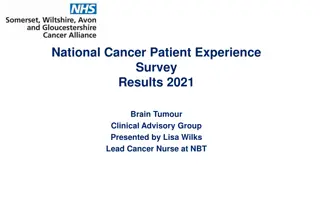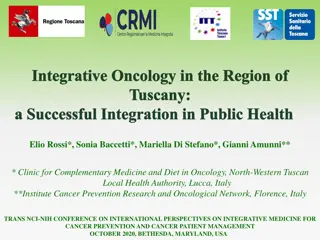Understanding Cancer Predispositions and Genetics in Pediatric Patients
Exploring cancer predisposition syndromes, basic genetics, and vocabulary related to pediatric cancer risk factors. Topics include CNS tumors, solid tumors, leukemia, hereditary retinoblastoma, and genetic testing guidelines for children with cancer predispositions.
Download Presentation

Please find below an Image/Link to download the presentation.
The content on the website is provided AS IS for your information and personal use only. It may not be sold, licensed, or shared on other websites without obtaining consent from the author. Download presentation by click this link. If you encounter any issues during the download, it is possible that the publisher has removed the file from their server.
E N D
Presentation Transcript
Cancer Cancer Predispositions Predispositions Julia Meade, MD UPMC Children s Hospital of Pittsburgh
This talk will follow the topical structure: This talk will follow the topical structure: Basic genetics and vocabulary Predisposition to CNS tumors Predisposition to solid tumors outside the CNS Predisposition to leukemia
Basic Genetics and Vocabulary Basic Genetics and Vocabulary
General Truths General Truths Cancer Predisposition Syndromes (CPS) are caused by a pathogenic variant in a single gene or gene complex (ex. TP53, SDHx) Almost all CPS follow an autosomal dominant (AD) inheritance pattern The correct tissue type when evaluating a patient with leukemia for a CPS is cultured skin fibroblasts Genetic testing occurs in childhood when screening and cancer prevention guidelines exists adult conditions are generally not tested until > 18 yo All CPS are rare incidence & prevalence are limited & not testable
Vocabulary Vocabulary Pathogenic variant disease-causing mutation Penetrance = the number of people with a pathogenic variant who go on to develop cancer Variable expressivity = the range of cancers a pathogenic variant can produce Anticipation = age of cancer onset decreases in subsequent generations De novo = not familial; the first member of a family to carry the pathogenic variant
Predisposition to CNS Tumors Predisposition to CNS Tumors
Hereditary Retinoblastoma Hereditary Retinoblastoma Gene mutated: RB1 CNS tumors: bilateral retinoblastoma, CNS embryonal midline tumor (pineoblastoma) Testing window: prenatal or at birth Avoid radiation therapy, UV light, tobacco Screening Guidelines Birth to 8 weeks Non-sedated eye exam every 2-4 weeks 8 weeks to 12 mo Monthly exam under anesthesia (EUA) 12 to 24 months EUA every 2 months 24 to 36 months EUA every 3 months 36 to 48 months EUA every 4 months 48 to 60 months EUA every 6 months
Neurofibromatosis 1 Neurofibromatosis 1 Gene: NF1 High variable expressivity CNS tumor: optic pathway glioma, low grade glioma Testing window: most diagnosed in infancy/childhood Other tumors: Physical Exam Findings in Children: Iris hamartomas (Lisch nodules) Caf au lait macules Plexiform neurofibromas Axillary or inguinal freckling Sphenoid wing dysplasia macrocephaly Malignant peripheral nerve sheath tumor (MPNST) Leukemia Gastrointestinal stromal tumors (GIST) Breast cancer
Neurofibromatosis 2 Neurofibromatosis 2 Gene: NF2 CNS tumor: bilateral vestibular schwannomas ~ age 18-24 Other tumors: meningioma, ependymoma, astrocytoma Testing window: infancy to adult Screening Guidelines Physical Exam Findings in Children: Intradermal schwannoma Retinal hamartoma Cortical wedge cataract meningioma Annual brain MRI beginning ~ age 10 Annual audiology evaluation
Nevoid Basal Cell Carcinoma Syndrome Nevoid Basal Cell Carcinoma Syndrome Gene: PTCH1 and SUFU Aka Gorlin Syndrome Testing window: infancy to adult CNS tumor: desmoplastic nodular medulloblastoma (mostly SUFU) Other tumors: Basal cell carcinoma of the skin Screening Guidelines Annual dermatology evaluation starting age 10 SUFU: consider brain MRI q3-4 mo until age 3, q6 mo until age 5 Orthopantomogram (Panorex) annually (PTCH1 only) Physical Exam Findings Macrocephaly Frontal bossing Coarse shaped facial features Facial milia Bifid ribs/wedge-shaped vertebrae Keratogenic cysts of the jaw (PTCH1 only) Cardiac or ovarian fibromas
Von Hippel Von Hippel- -Lindau Syndrome Lindau Syndrome Gene mutated: VHL CNS tumor: hemangioblastoma, retinal angioma Testing window: early childhood to adult 70% develop renal cell carcinoma (#1 cause of death) Other tumors: pheochromocytoma, endodermal sinus tumors (ear), Screening Guidelines Annual eye exam starting at birth Brain & spine MRI every other year, starting age 8 Annual abdomen MRI, starting at 10 Audiogram every other year, starting age 5
Rhabdoid Tumor Predisposition (RTP) Rhabdoid Tumor Predisposition (RTP) Type I Type I Gene: SMARCB1 CNS tumor: atypical teratoid/rhabdoid tumor (AT/RT), schwannomas, meningiomas Testing window: birth/infancy 25-35% of children with AT/RT have a germline RTP mutation Other tumors: malignant rhabdoid tumor of the kidney (MRT) Screening Guidelines MRI brain q3 mo until age 5 Abdominal US q3 mo - no clear end point
Constitutional Mismatch Repair Deficiency (CMMRD) Constitutional Mismatch Repair Deficiency (CMMRD) Gene mutated: MSH2, MLH1, MSH6, PMS2 Mode of inheritance: recessive Both parents have Lynch syndrome CNS tumor: hypermutated high grade glioma Testing window: birth to adult Other tumors: Physical Exam Findings in Children: Caf au lait macules May mimic NF1 Screening Guidelines Annual whole body MRI Colon cancer Annual CBC Leukemia Abdominal ultrasound 3 times/year
Predisposition to solid Tumors Predisposition to solid Tumors
Li Li- -Fraumeni Syndrome Fraumeni Syndrome Gene: TP53, Chromosome 17 High variable expressivity & penetrance Testing window: birth to adult Tumor types: Screening Guidelines Annual whole body MRI Osteosarcoma Annual brain MRI (1st w/contrast, then w/o) Adrenocortical carcinoma Abdominal US every 3 months (not with MRI) Anaplastic embryonal rhabdomyosarcoma Annual skin exam Choroid plexus carcinoma Breast cancer (20s-30s, triple positive) Hypodiploid pre-B ALL
Rothmund Rothmund- -Thomson Syndrome Thomson Syndrome type II type II Gene: RECQL4 Autosomal recessive Solid tumor: osteosarcoma (multicentric) Occurs in ~ 30% of patients with RTS Physical Exam Findings: Poikiloderma facial rash short stature sparse scalp hair sparse or absent eyelashes and/or eyebrows juvenile cataracts skeletal abnormalities frontal bossing radial ray defects premature aging
PTEN PTEN- -Hamartoma Syndrome Hamartoma Syndrome Gene: PTEN Aka: Cowden Syndrome Testing window: infancy/childhood to adult Solid tumor: papillary thyroid cancer, lipomas, GI hamartomas, breast cancer Screening Guidelines Physical Exam Findings Macrocephaly Intellectual disability Trichilemmoma (subcutaneous lumps) Every other year thyroid ultrasound starting age 7
Multiple Endocrine Neoplasia 1 (MEN1) Multiple Endocrine Neoplasia 1 (MEN1) Gene: MEN1 Highly penetrant - 70% penetrance by age 50 Most cancers secrete hormones eg. Insulin, prolactin Most common tumors: Pancreatic neuroendocrine tumors Pituitary adenomas Parathyroid tumors Primary hyperparathyroidism is a common presentation
MEN2A & MEN2B MEN2A & MEN2B Gene: RET (activating) Testing window: infancy to childhood MEN2A ~ 95% of all MEN2 cases 100% penetrance of medullary thyroid cancer (MTC) Primary hyperparathyroidism (PHPT) Thyroidectomy before age 5 MEN2B 5% of MEN2 cases 100% penetrance of v. aggressive MTC NO PHPT Thyroidectomy before age 1 Both with increased risk for pheochromocytoma
MEN4 MEN4 Gene: CDKN1B Most common tumors: Pituitary adenomas Parathyroid tumors Genito-urinary tumors Commonly present with hyperparathyroidism Often discovered when genetic testing for MEN1 is negative
DICER1 syndrome DICER1 syndrome Gene mutated: DICER1 Testing window: infancy to adult Most common solid tumors: Screening Guidelines Chest CT at 3-6 months of age Chest CT at 2.5-3 years of age Chest X-ray every 6 months until age 8 Abdominal ultrasound every 6 months starting at birth, consider pelvis as well; upper age limit not well defined Pleuropulmonary blastoma Cystic nephroma Thyroid US every 3 years starting at age 8 Sertoli-Leydig cell tumor of the ovary (germ cell tumor) Papillary or follicular thyroid cancer
Familial Adenomatous Polyposis (FAP) Familial Adenomatous Polyposis (FAP) Gene mutated: APC Testing window: infancy to AYA/adult Solid tumors: Screening Guidelines Quarterly AFP and abdominal ultrasounds from birth through the 4th birthday Colonoscopy beginning age 12 Think MUTYH with negative APC gene mutation and no family history of polyps/colon cancer recessive colon cancer predisposition syndrome Hepatoblastoma (Incidence < 2%) Abdominal desmoid tumors (Gardner Syndrome) CNS embryonal tumor (Turcot Syndrome) Colon cancer
Hereditary Pheochromocytoma/Paraganglioma Syndrome Hereditary Pheochromocytoma/Paraganglioma Syndrome Gene mutated: SDHA, SDHB, SDHC, SDHB (aka SDHx) Testing window: early childhood to adult ~ 30% of pheochromocytomas are due to a CPS SDHB = most likely to metastasize (think B for BAD) Other tumors: Screening Guidelines Whole body MRI every other year, starting ages 6-8 Renal cell carcinoma Papillary thyroid carcinoma Annual plasma free or 24-hour urine metanephrines Pituitary adenoma Annual plasma methoxytyramine GI neuroendocrine tumors (GIST) common w/SDHA Annual blood pressure measurements
Hereditary Neuroblastoma Hereditary Neuroblastoma Genes: PHOX2B, ALK (activating mutation), RASopathies PHOX2B = also causes congenital central hypoventilation syndrome, Hirschprung s disease Highly penetrant Testing window: birth/infancy Screening Guidelines (ALK & PHOX2B) Abdominal US, urine HVA/VMA, CXR quarterly starting at birth to age 6 Abdominal US, urine HVA/VMA, CXR every 6 months starting at age 6 until 10
Wilms Tumor (WT) Predisposition(s) Wilms Tumor (WT) Predisposition(s) Gene: WT1 and the 11p15.5 locus WAGR (WT, aniridia, GU abnormalities, intellectual disability) = WT1 + PAX6 Denys-Drash = WT exon 8 or 9 kidney diffuse mesangial sclerosis Frasier Syndrome = WT1 intron 9 donor splice site Perlman Syndrome = DIS3L2 gene, polydactyly, fetal ascites Bohring-Optiz Syndrome = ASXL1 gene, very syndromic w/intellectual disability Screening Guidelines Renal ultrasounds every 3 months from birth through age 7
Bloom Syndrome Bloom Syndrome Gene: BLM Autosomal recessive Tumors: Wilms Tumor, GI/colon cancer, breast cancer, leukemias Increased toxicity to radiation and chemo, need dose reductions Screening Guidelines Physical Exam Findings in Children: Slow/poor growth Narrow head/face Butterfly rash on face telangiectasias Caf au lait macules photosensitivity Abdominal US q3mo until age 8 for WT Colonoscopy starting age 12 Breast MRI starting age 18 Whole-body MRI every 1-2 years
Beckwith Beckwith- -Wiedemann Syndrome Wiedemann Syndrome Gene mutated: imprinting defect on chromosome 11p15.5 Confirmatory test: DNA methylation profile Solid tumors: hepatoblastoma & Wilms tumor Same screening applies to Simpson-Golabi-Behmel Syndrome & Trisomy 18 Physical Exam Findings in Children: Large tongue Hemihyperplasia Macrocephaly Omphalocele at birth Splenomegaly/viceromegaly Screening Guidelines Renal ultrasounds every 3 months from birth through age 7 Abdominal ultrasounds and AFP level every 3 months from birth through age 4
FH Tumor Predisposition Syndrome FH Tumor Predisposition Syndrome Gene: fumarate hydratase (FH) Aka: Hereditary Leiomyomatosis and Renal Cell Carcinoma (HLRCC) Screening Guidelines Annual abdominal MRI starting age 8 Annual dermatologic evaluation
Rhabdoid Tumor Predisposition Rhabdoid Tumor Predisposition Type II Type II Gene mutated: SMARCA4 Solid tumor: small cell carcinoma of the ovary hypercalcemic type (SCCOHT) CNS tumor: rare AT/RT Testing window: childhood Screening Guidelines Pelvic US q3-6 mo Consider risk reducing bilateral oophorectomy
Predisposition to leukemias Predisposition to leukemias
Noonan Syndrome Noonan Syndrome Genes: PTPN11, SOS1, RAF1 and KRAS Leukemia type: Juvenile Myelomonocytic leukemia (JMML) and ALL Testing window: infancy to adult No leukemia screening guidelines Physical Exam Findings in Children: Small/short stature strabismus Pulmonary valve stenosis Shield chest with wide-spaced nipples Short neck, high palate, low-set ears
Familial Platelet Disorder with associated myeloid Familial Platelet Disorder with associated myeloid malignancy malignancy Gene mutated: RUNX1 Leukemia type: MDS/AML can see monosomy 7 35-40% risk of developing leukemia, exhibits anticipation aspirin-like platelet defect, mild thrombocytopenia, can mimic ITP No leukemia screening guidelines
Thrombocytopenia 5 Thrombocytopenia 5 Gene mutated: ETV6 Leukemia type: pre-B ALL (hyperdiploid), MDS/AML ~ 1 % of patients with pre-B ALL have Thrombocytopenia 5 Mild thrombocytopenia, mild bleeding phenotype No leukemia screening guidelines
ANKRD26 ANKRD26- -related thrombocytopenia related thrombocytopenia Gene mutated: ANKRD26 Aka: Thrombocytopenia 2 Leukemia type: AML (~ 8% of affected individuals) Hematologic findings: moderate thrombocytopenia (50-150 x109/L), mild bleeding phenotype No leukemia screening guidelines
CEBPA CEBPA- -Associated Familial Acute Myeloid Leukemia Associated Familial Acute Myeloid Leukemia Gene mutated: CEBPA Leukemia type: AML Leukemia should demonstrate two variants in CEBPA on sequencing Germline should demonstrate one pathogenic variant Highly penetrant No leukemia screening guidelines
Further Reading Further Reading Clinical Cancer Research (CCR) Pediatric Oncology Series on Pediatric Cancer Predisposition. Volume 23, Issue 13, July 2017. Surveillance Recommendations for Children with Overgrowth Syndromes and Predisposition to Wilms Tumors and Hepatoblastoma Multiple Endocrine Neoplasia and Hyperparathyroid-Jaw Tumor Syndromes: Clinical Features, Genetics, and Surveillance Recommendations in Childhood Cancer Screening Recommendations and Clinical Management of Inherited Gastrointestinal Cancer Syndromes in Childhood
